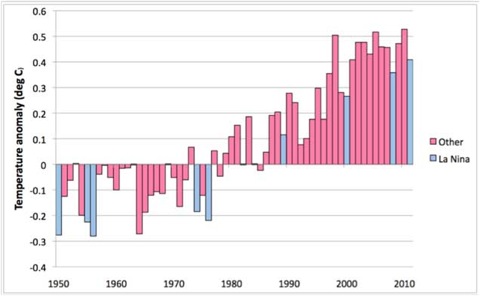 ‘Tis the silly season, time for journalists with little real news to report to reflect on the year past and make predictions for the year to come. I don’t normally play that game because there are too many interesting things to write about on the climate beat, but this year I’m going to make an exception. Glenn “Climate Show” Williams persuaded me to have a chat with him on his summer Radio Live show — and yes, we did cover the last year, and the prospects for 2012. The audio’s available to stream for the next week from the Radio Live site (select Dec 28th, then the 1-15pm segment — my bit starts after about 5 minutes). You may regard this post as an expanded version of my comments there (and a bit of recap on the last Climate Show of the year).
‘Tis the silly season, time for journalists with little real news to report to reflect on the year past and make predictions for the year to come. I don’t normally play that game because there are too many interesting things to write about on the climate beat, but this year I’m going to make an exception. Glenn “Climate Show” Williams persuaded me to have a chat with him on his summer Radio Live show — and yes, we did cover the last year, and the prospects for 2012. The audio’s available to stream for the next week from the Radio Live site (select Dec 28th, then the 1-15pm segment — my bit starts after about 5 minutes). You may regard this post as an expanded version of my comments there (and a bit of recap on the last Climate Show of the year).
So: 2011 was the year of extremes, beyond any shadow of doubt. Wherever you looked around the world, there were record-breaking floods, heatwaves and hugely damaging extreme weather events. The USA alone had 14 separate extreme weather events with billion dollar plus damage bills (NOAA puts it at 12 with 2 more to finalise, the World Meteorological Organisation plumps for 14). The year broke no records for global average temperature — 2011 will probably end up as the 10th or 11th warmest year in the long term record — but it will be the warmest ever La Niña year. Here’s a WMO graph to illustrate the point:

The prospects for 2012 depend in large part on what happens to the El Niño Southern Oscillation this year. Will the current La Niña hang around for another year, decay to neutral conditions, or swing round to an El Niño? The odds, according to NOAA’s Klaus Wolters (on Dec 7th) are interesting:
Based on current atmosphere-ocean conditions, I believe the odds for this La Niña event to continue right through early spring (March-April 2012) are higher than 50%. Beyond that, it is worth noting that of the ten two-year La Niña events between 1900 and 2009, four ended up as a three-year event, so I would put the odds for this to occur in 2012-13 at 40% right now. Interestingly, the other six all switched to El Niño, leaving no ENSO-neutral case. Will be interesting to see how 2012 evolves.
It will indeed. A return to El Niño conditions in the first half of 2012 would boost global average temperatures, and that, coupled with the currently active phase of the 11 year solar cycle, might be enough to push 2012 above 2010 and 2005 for a new record. But more importantly, a return to El Niño would also change the patterns of weather around the world, and with them change the places that experience record extremes. Exactly how this will play out is impossible to predict, because the timing of a move out of La Niña conditions is difficult to forecast, and because the nature of El Niño’s impacts on weather patterns around there planet depend on the season (see Wikipedia, NOAA and NIWA for more).
So what do am I looking out for in 2012?
- More extreme weather events, with a pattern shift if ENSO changes phase.
- Possible new global temperature record, if El Niño arrives early enough in the year.
- Continued Arctic sea ice melt (in both volume and area), with a possibility ((No I’m not betting, but greater than 50% chance, I’d say, because at some point volume reductions have to show up in extent/area numbers.)) of a new record minimum in September.
- Lots of fine words at the Rio +20 conference in June, but little concrete action. Ditto for COP 18 in Qatar in December.
- At least one nasty surprise emerging from current research. I hope it isn’t East Siberian seabed methane, but we’ll know more when the papers describing the 2011 Arctic research season are published.
And a very happy new year for all Hot Topic readers…
[Update 31/12: Jeff Masters’ end of year review counts “32 weather disasters costing at least $1 billion worldwide. Five nations experienced their most expensive weather-related natural disasters on record during 2011–Thailand, Australia, Colombia, Sri Lanka, and Cambodia.” The year of extremes, indeed…]
[youtube]Zn2JFlteeJ0[/youtube]

Kudos to Jim Renwick, interviewed in DomPost. His blunt dismissal of the “debate” over AGW is most refreshing (not online unfortunately at present), especially after the polluting effects of the noxious stuff retailed here by a succession of climate trolls.
Yes, and it’s aslo The Year of the Protester . Bravo to all the AGW deniers !
But is modern capitalism sustainable ? Here’s Kenneth Rogoff, professor of economics at Harvard, ex Chief Economist at the IMF.
“…I am often asked if the recent global financial crisis marks the beginning of the end of modern capitalism. It is a curious question, because it seems to presume that there is a viable replacement waiting in the wings. The truth of the matter is that, for now at least, the only serious alternatives to today’s dominant Anglo-American paradigm are other forms of capitalism…”
http://www.project-syndicate.org/commentary/rogoff87/English
Food for thought.
He’s an economist – and he would say that wouldn’t he!
The difference between scientists and economists is that the former base their theories on verifiable repeatable observations of the real world, whereas economists base their ideas on gut feelings (ideology) and misconceptions (continued growth) glossed over with hocus-pocus “mathematical models” that are supposed to replicate reality but in fact are far from it.
…and here’s the IPCC re sea level rises…
“Despite this error, the IPCC has long been a fairly reliable source of sensible and responsible estimates in an otherwise histrionic debate. Unfortunately, sensible estimates are not breaking news. For example, according to the IPCC, sea levels will rise by a relatively manageable 18-59 centimeters (7-23 inches) by the end of the century, whereas news organizations and activists regularly claim that we should expect sea levels to rise by meters…”
…and hurricane damage…
“The IPCC clearly states that hurricane-damage costs have increased steadily because more people, with more expensive property, now live where hurricanes strike. Population, exposure, and vulnerability, not greenhouse gasses, are the main factors underlying future damage as well.
Indeed, the IPCC observes that increased hurricane costs “have not been attributed to climate change.” Thus, if we want to avoid future hurricane damage, we need to invest in adaptation. That means better risk management, including stricter building codes and improved wetlands to slow storm surges…”
Caution: this is from your arch traitor Bjorn Lomborg…
http://www.project-syndicate.org/commentary/lomborg79/English
More Lomborg lies: he misquotes AR4 (as usual) by omitting their important caveat – the numbers exclude any contribution from increased ice sheet melt. And, as he well knows, we are seeing increased and increasing ice sheet melt.
The IPCC extremes report, by being very cautious about its conclusions, is manna for a Lomborg, intent on downplaying the impact of extreme weather events. I’m with Trenberth: every weather event now takes place in a climate that’s changed considerably from that of 30 years ago.
Now go and read the update to the post.
Off (Hot) Topic, but it’s worth a trip to the movies to see Meryl Streep as Maggie Thatcher.
Tories like me are positively purring…
“So what do am I looking out for in 2012?
* More extreme weather events, with a pattern shift if ENSO changes phase.
* Possible new global temperature record, if El Niño arrives early enough in the year.”
The odds?
Official Early-Feb CPC/IRI Consensus Probabilistic ENSO Forecst
–Made in Feb 2012–
Season SON 2012 (Sept-Oct-Nov)
31% La Niña
37% Neutral
32% El Niño
http://iri.columbia.edu/climate/ENSO/currentinfo/figure1.html
Like Waiting for Godot.